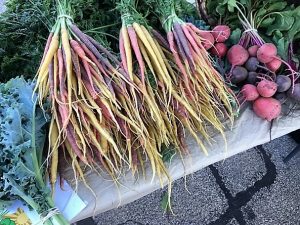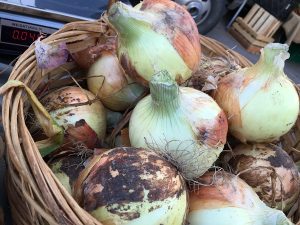 It’s July, and we’re approaching peak farmers’ market season. The first major waves of anticipated foods have come and gone (asparagus, strawberries, rhubarb, sigh), but we are readily consoled by blueberries, tomatoes, sweet corn, peppers, and my personal favorite, peaches. When the season hits this strong, and the weather’s finally nice, and we’re surrounded by like-minded folks who love fresh local food, it can be easy to forget that despite its popularity, not everyone is quite as giddy with anticipation for the start of farmers’ market season. That it takes time to make a market a key part of a shopper’s weekly routine, time to build those relationships with farmers that keep the customers coming back, time for a market to become a pillar of the community.Farmers’ markets saw a strong resurgence at the beginning of the 2000’s, becoming a trendy place to buy healthy food or sell fancy, artisan foods. Their popularity continues today, though the past 5-10 years have often seen a drop in sales. Part of that is due to dilution. Suddenly every town, every suburb, every neighborhood wanted its own market, which put a strain on the farmers who supply them. Artisan food vendors have found farmers’ markets to be an effective sales venue, but the new customers they bring in don’t always translate into sales for the farmers. Some farmers have grown increasingly concerned that the farmers’ market has become more of a social gathering spot, rather than a shopping opportunity.
It’s July, and we’re approaching peak farmers’ market season. The first major waves of anticipated foods have come and gone (asparagus, strawberries, rhubarb, sigh), but we are readily consoled by blueberries, tomatoes, sweet corn, peppers, and my personal favorite, peaches. When the season hits this strong, and the weather’s finally nice, and we’re surrounded by like-minded folks who love fresh local food, it can be easy to forget that despite its popularity, not everyone is quite as giddy with anticipation for the start of farmers’ market season. That it takes time to make a market a key part of a shopper’s weekly routine, time to build those relationships with farmers that keep the customers coming back, time for a market to become a pillar of the community.Farmers’ markets saw a strong resurgence at the beginning of the 2000’s, becoming a trendy place to buy healthy food or sell fancy, artisan foods. Their popularity continues today, though the past 5-10 years have often seen a drop in sales. Part of that is due to dilution. Suddenly every town, every suburb, every neighborhood wanted its own market, which put a strain on the farmers who supply them. Artisan food vendors have found farmers’ markets to be an effective sales venue, but the new customers they bring in don’t always translate into sales for the farmers. Some farmers have grown increasingly concerned that the farmers’ market has become more of a social gathering spot, rather than a shopping opportunity.
 So what are we doing at The Land Connection to build our market in a way that avoids falling into these traps? Fortunately we started out with a very clear vision, which has informed how the market has developed every step along the way. Our goal has always been first and foremost to support small, local farms by providing them with an additional sales outlet. In doing so, we seek to connect the whole community with local food. As the market manager, I really want to do as much as I can to change the perception that a farmers’ market is just a trendy, expensive, yuppie place to buy fancy food. I want people to understand the value of buying local food, to understand how hard our farmers are working to bring us all this food, and to not feel intimidated by unfamiliar products.To this end we did not fill the market up with non-farmer vendors. We could have easily filled the market with prepared food vendors and craftspeople, and there is no shortage of these types of vendors who are very skilled in and around Champaign-Urbana. We wanted to leave room for the farmers, however, and make them the focal part of the market. We’ve been very fortunate to see our vendors connect with each other. This year we’ve seen even more collaboration, with bakers using flour from one vendor, and fruit from another for their creations. They work hard to promote each other, and this sense of community among vendors has been one of the best developments of the Market so far.
So what are we doing at The Land Connection to build our market in a way that avoids falling into these traps? Fortunately we started out with a very clear vision, which has informed how the market has developed every step along the way. Our goal has always been first and foremost to support small, local farms by providing them with an additional sales outlet. In doing so, we seek to connect the whole community with local food. As the market manager, I really want to do as much as I can to change the perception that a farmers’ market is just a trendy, expensive, yuppie place to buy fancy food. I want people to understand the value of buying local food, to understand how hard our farmers are working to bring us all this food, and to not feel intimidated by unfamiliar products.To this end we did not fill the market up with non-farmer vendors. We could have easily filled the market with prepared food vendors and craftspeople, and there is no shortage of these types of vendors who are very skilled in and around Champaign-Urbana. We wanted to leave room for the farmers, however, and make them the focal part of the market. We’ve been very fortunate to see our vendors connect with each other. This year we’ve seen even more collaboration, with bakers using flour from one vendor, and fruit from another for their creations. They work hard to promote each other, and this sense of community among vendors has been one of the best developments of the Market so far.
 We also worked hard to figure out ways to not just draw people to the market, but to entice them to shop. First and foremost we built up the SNAP matching program as a cornerstone of the market. By providing an opportunity for SNAP recipients not only to have a chance to use those benefits on local food, but also receive extra funds to expand their food budget, we are moving back towards the original intention behind the food stamps program: connecting farmers who are having trouble selling excess produce with hungry people who need access to food. We also want to take away some of the fear of working with unfamiliar produce, which is the motivation behind the Farm Fresh Now! series of recipe cards, and the start of our Sampling Tent in this second season, which Cassie wrote about last week. Both have been successful in helping boost sales of products that can be difficult to move, and we’re working towards even more intricate chef demos and interesting dishes.Finally, we’ve worked hard to get the whole community behind this market. Especially for a new farmers’ market, community support is critical. Research has shown it typically takes 3-4 years for a market to truly establish itself. Once the shininess of a market’s launch wears off, it takes extensive promotion from all sides to get the shoppers out. We rely on our farmers, the community groups who join us, our sponsors, downtown businesses, our volunteers, and our shoppers to help us get the word out about all that the market has to offer. We’re very fortunate to see so many of our sponsors and board members out shopping at the market each week. We’re seeing a core base of regular customers, who even come out in the rain! As we have earned a more prominent place on the community’s radar, we’re now approached by more and more local businesses and organizations who want to be a part of the Market.
We also worked hard to figure out ways to not just draw people to the market, but to entice them to shop. First and foremost we built up the SNAP matching program as a cornerstone of the market. By providing an opportunity for SNAP recipients not only to have a chance to use those benefits on local food, but also receive extra funds to expand their food budget, we are moving back towards the original intention behind the food stamps program: connecting farmers who are having trouble selling excess produce with hungry people who need access to food. We also want to take away some of the fear of working with unfamiliar produce, which is the motivation behind the Farm Fresh Now! series of recipe cards, and the start of our Sampling Tent in this second season, which Cassie wrote about last week. Both have been successful in helping boost sales of products that can be difficult to move, and we’re working towards even more intricate chef demos and interesting dishes.Finally, we’ve worked hard to get the whole community behind this market. Especially for a new farmers’ market, community support is critical. Research has shown it typically takes 3-4 years for a market to truly establish itself. Once the shininess of a market’s launch wears off, it takes extensive promotion from all sides to get the shoppers out. We rely on our farmers, the community groups who join us, our sponsors, downtown businesses, our volunteers, and our shoppers to help us get the word out about all that the market has to offer. We’re very fortunate to see so many of our sponsors and board members out shopping at the market each week. We’re seeing a core base of regular customers, who even come out in the rain! As we have earned a more prominent place on the community’s radar, we’re now approached by more and more local businesses and organizations who want to be a part of the Market.

With persistence and patience, we can ensure this market continues to grow and cement its place on the local food scene. Thank you to all who have been a part of Market community. If you’re looking for ways to get involved, you can help by sharing the Market on your social networks, by volunteering, by becoming a sponsor, and above all, by coming out and buying great local food, every Tuesday through October from 4-7 in Downtown Champaign!


